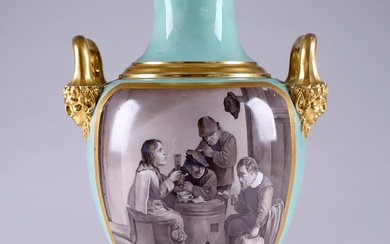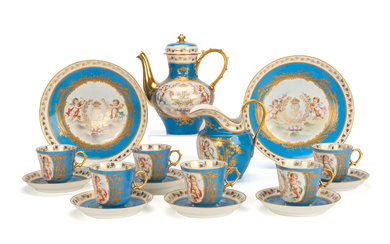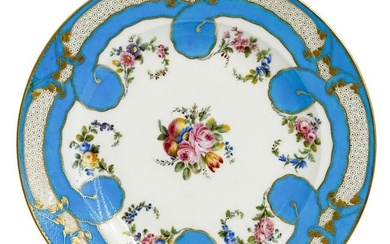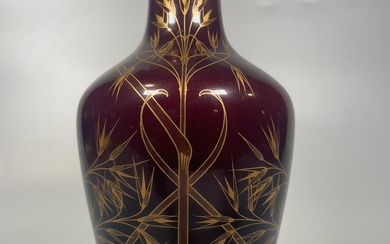A very rare Sèvres footed bowl (coupe à bouillon hémisphérique) and stand, circa 1813-14
Of mosaïque et poissons decoration, the well of the stand finely painted with a medallion of sea shells and coral on a faux-porphyry ground within a hexagonal panel on a marbled ground decorated with palmettes alternating with flowerhead roundels, the rim border with six panels depicting colourful fish on faux-malachite ground between trelliswork panels, the coupe similarly decorated and applied with looped handles, on a gilt foot with tooled leaf border, the coupe: 14.5cm diam.; the stand: 23.5cm diam., crowned eagle and Manufacture Impériale/SEVRES stencilled in iron-red to stand, traces of Sevres in iron-red to coupe, incised marks, QZ and 18 mar(?) in gilding to both (2)
Provenance:
Probably Jérôme Bonaparte (1784-1860), King of Westphalia, between 1807 and 1813;
Diane Duchess of Württemberg, née Princesse d'Orléans (1940-);
Twinight Collection, no. 2128 (label to underside)
From 1800 onwards the new director of the Sèvres manufactory, Alexandre Brongniart (1770-1847), renewed the formal and ornamental repertoires of the factory's production. During the Empire, he favoured forms after the Antique, drawing inspiration from the collection of Etruscan ceramics belonging to Baron Dominique Vivant Denon (1747-1825), which had been sold to the Sèvres factory in 1786.
The neo-classical shape of this bouillon bowl is a testament to this. A first drawing of this shape, probably by Claude-Charles Gérard in 1803, bears the inscription 'Coupe à bouillon et sa soucoupe à deux anses à moulures an XI mois ventôse' [Bouillon cup and saucer with two handles with mouldings in the 11th month of Ventôse] (February-March 1803). The actual name of 'coupe à bouillon hémisphérique' however does not appear until 1804, on a drawing by Charles-Eloi Asselin (Sèvres, Cité de la Céramique, inv. 2011.3.2105, ill. 1).
The technical improvements made during the First Empire made it possible to create painted and gilt decoration of unparalleled quality. The manufactory developed new decorative schemes based on nature, proof of the interest in natural history at the beginning of the 19th century. These included depictions of hard stones, precious stones, marble, fauna and flora, sometimes called mosaïque, as can be seen on the present lot. Like the royal factories of Vienna and Berlin, Sèvres explored the decorative elements based on the art of trompe-l'oeil, mixing different coloured backgrounds and material effects.
A similarly decorated cabaret service was presented to the Countess de Montesquiou as a New Year's present in 1813, now at the Cooper Hewitt Museum. This kind of richly decorated coupe was a common New Year's gift from the Emperor's household. A 'coupe à bouillon hémisphérique' decorated with a horse race on the Champ de Mars was offered as a New Year's present in 1812 to the Countess of Montalivet and is now in the Château de Fontainebleau.
On 12 May 1814, two coupes of this shape with decoration en imitation de mosaïque, were entered in the sale records. Unfortunately, it is not possible to precisely identify the present lot. However, the records from 1815 that relate to porcelain delivered to the Bonaparte family by the order of the Prussian Commissioner Kapsh mention two bowls of this shape with relief decoration, certainly the same coupes as those entered in May 1814.
Jérôme Bonaparte, King of Westphalia
Jérôme Bonaparte (1784-1860) was a French prince, the son of Charles-Marie Bonaparte and Maria-Létizia Ramolino, and Napoleon's youngest brother. He was King of Westphalia from 1807 to 1813.
In August 1807, his brother arranged for him to marry Princess Catherine of Württemberg, daughter of Frederick I of Württemberg, and six days later, he was appointed King of Westphalia.
Diane, Duchess of Württemberg
Princess Diane of France, née Diane d'Orléans (1940 -), and Duchess of Württemberg is married to Charles Marie Duke of Württemberg, current head of the House of Württemberg. He belongs to the fifth branch of the House of Württemberg and a descendant of Alexander of Württemberg (1771-1833), the brother of Frederick I of Württemberg and the father of Catherine, the wife of Jérôme Bonaparte.
View it on
Sale price
Estimate
Time, Location
Auction House
Of mosaïque et poissons decoration, the well of the stand finely painted with a medallion of sea shells and coral on a faux-porphyry ground within a hexagonal panel on a marbled ground decorated with palmettes alternating with flowerhead roundels, the rim border with six panels depicting colourful fish on faux-malachite ground between trelliswork panels, the coupe similarly decorated and applied with looped handles, on a gilt foot with tooled leaf border, the coupe: 14.5cm diam.; the stand: 23.5cm diam., crowned eagle and Manufacture Impériale/SEVRES stencilled in iron-red to stand, traces of Sevres in iron-red to coupe, incised marks, QZ and 18 mar(?) in gilding to both (2)
Provenance:
Probably Jérôme Bonaparte (1784-1860), King of Westphalia, between 1807 and 1813;
Diane Duchess of Württemberg, née Princesse d'Orléans (1940-);
Twinight Collection, no. 2128 (label to underside)
From 1800 onwards the new director of the Sèvres manufactory, Alexandre Brongniart (1770-1847), renewed the formal and ornamental repertoires of the factory's production. During the Empire, he favoured forms after the Antique, drawing inspiration from the collection of Etruscan ceramics belonging to Baron Dominique Vivant Denon (1747-1825), which had been sold to the Sèvres factory in 1786.
The neo-classical shape of this bouillon bowl is a testament to this. A first drawing of this shape, probably by Claude-Charles Gérard in 1803, bears the inscription 'Coupe à bouillon et sa soucoupe à deux anses à moulures an XI mois ventôse' [Bouillon cup and saucer with two handles with mouldings in the 11th month of Ventôse] (February-March 1803). The actual name of 'coupe à bouillon hémisphérique' however does not appear until 1804, on a drawing by Charles-Eloi Asselin (Sèvres, Cité de la Céramique, inv. 2011.3.2105, ill. 1).
The technical improvements made during the First Empire made it possible to create painted and gilt decoration of unparalleled quality. The manufactory developed new decorative schemes based on nature, proof of the interest in natural history at the beginning of the 19th century. These included depictions of hard stones, precious stones, marble, fauna and flora, sometimes called mosaïque, as can be seen on the present lot. Like the royal factories of Vienna and Berlin, Sèvres explored the decorative elements based on the art of trompe-l'oeil, mixing different coloured backgrounds and material effects.
A similarly decorated cabaret service was presented to the Countess de Montesquiou as a New Year's present in 1813, now at the Cooper Hewitt Museum. This kind of richly decorated coupe was a common New Year's gift from the Emperor's household. A 'coupe à bouillon hémisphérique' decorated with a horse race on the Champ de Mars was offered as a New Year's present in 1812 to the Countess of Montalivet and is now in the Château de Fontainebleau.
On 12 May 1814, two coupes of this shape with decoration en imitation de mosaïque, were entered in the sale records. Unfortunately, it is not possible to precisely identify the present lot. However, the records from 1815 that relate to porcelain delivered to the Bonaparte family by the order of the Prussian Commissioner Kapsh mention two bowls of this shape with relief decoration, certainly the same coupes as those entered in May 1814.
Jérôme Bonaparte, King of Westphalia
Jérôme Bonaparte (1784-1860) was a French prince, the son of Charles-Marie Bonaparte and Maria-Létizia Ramolino, and Napoleon's youngest brother. He was King of Westphalia from 1807 to 1813.
In August 1807, his brother arranged for him to marry Princess Catherine of Württemberg, daughter of Frederick I of Württemberg, and six days later, he was appointed King of Westphalia.
Diane, Duchess of Württemberg
Princess Diane of France, née Diane d'Orléans (1940 -), and Duchess of Württemberg is married to Charles Marie Duke of Württemberg, current head of the House of Württemberg. He belongs to the fifth branch of the House of Württemberg and a descendant of Alexander of Württemberg (1771-1833), the brother of Frederick I of Württemberg and the father of Catherine, the wife of Jérôme Bonaparte.







